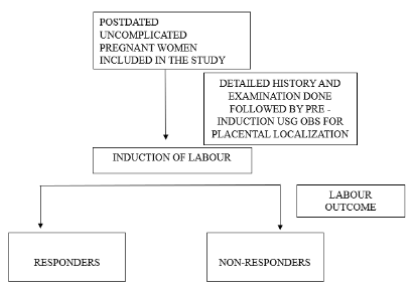Association of Placental Localization with Outcome of Induction of Labor in Post Dated Uncomplicated Pregnancy
Main Article Content
Abstract
Aim: The aim of this study is to evaluate the association of placental localization and outcome of induction of labor in uncomplicated postdated pregnancy.
Methods: It was prospective observational study done over a period of one month. The women with uncomplicated postdated singleton pregnancy who failed to enter spontaneous labor and were willing to participate in the study and who met the inclusion and exclusion criteria were enrolled. A total of 70 women were recruited and underwent clinical and ultrasound examination. Eligible enrolled women were induced by an intravaginal prostaglandin according to hospital protocol. According to the type of response to induction, women were divided into two group responder and non responder group.
Results: Among 70 enrolled participants 47% (n=33) women had anteriorly located placenta, 47.1% (n=32) women had posteriorly located placenta and 7.1% (n=5) had fundal placenta. Women with advanced maternal age (p<0.032) and urban resident females (p<0.001) had higher rate of failed induction of labor. Women with anteriorly located placenta showed a higher incidence of failed induction of labor (p< 0.001) in postdated uncomplicated singleton pregnancies and had higher rate of cesarean section.
Conclusion: An ultrasound based predictive model has been framed through this study based on the fact that anteriorly placed placenta has a significant association with failed induction of labor and thus help to identify postdated pregnant females who might have poor outcome of labor induction.
Article Details
References
Naeye RL: Causes of perinatal mortality excess in prolonged gestations. Am J Epidemiol 108: 429, 1978
Bodner-Adler B1, Bodner K, Pateisky N, Kimberger O, Chalubinski K, Mayerhofer K, Husslein P. Influence of labour induction on obstetric outcomes in patients with prolonged Pregnancy. Wiener klinische Wochenschrift April 2005, 117(7–8), 287–292.
Osterman MJK, Martin JA. Recent declines in induction of labour by gestational age. NCHS data brief. 2014;155:1-8.
Heffner LJ, Elkin E, Fretts RC. Impact of labor induction, gestational age, and maternal age on cesarean delivery rates. Obstet Gynecol. 2003 Aug;102(2):287-93. doi: 10.1016/s0029-7844(03)00531-3. PMID: 12907101
King DL. Placental migration demonstrated by ultrasonography. A hypothesis of dynamic placentation. Radiology 1973;109:167e70.
Zia S. Placental location and pregnancy outcome. J Turk Ger Gynecol Assoc 2013;1(14):190e3
Alessandro Favilli, Marta Maddalena Acanfora, Vittorio Bini, Roberta Radicchi, Gian Carlo Di Renzo & Sandro Gerli (2013) Single indication of labor induction with prostaglandins: is advanced maternal age a risk factor for cesarean section? A matched retrospective cohort study, The Journal of Maternal-Fetal & Neonatal Medicine, 26:7, 665-668, DOI: 10.3109/14767058.2012.746658
Mularz, Amanda MD; Gutkin, Rachel MD, MPH Maternal Age and Successful Induction of Labor in the United States, 2006–2010, Obstetrics & Gynecology: May 2014 - Volume 123 - Issue - p 73S doi: 10.1097/01.AOG.0000447388.42444.21
Harris VG. Relation between placental site and length of gestation. Br J Obstet Gynaecol 1975;82:581e4.
Buhimschi C, Boyle MB, Garfield RE. Electrical activity of the human uterus during pregnancy as recorded from the abdominal surface. Obstet Gynecol 1997;90:102e11.
Torricelli M, Vannuccini S, Moncini I, Cannoni A, Voltolini C, Conti N, Di Tommaso M, Severi FM, Petraglia F. Anterior placental location influences onset and progress of labor and postpartum outcome. Placenta. 2015 Apr;36(4):463-6. doi: 10.1016/j.placenta.2014.12.018. Epub 2014 Dec 27. PMID: 25573094.

